Menu editor
One common task you need to do is organize your sidebar resources into menus. You can easily do that using the menu editor in the initializer.
When you start with Avo, you'll get an auto-generated sidebar by default. That sidebar will contain all your resources, dashboards, and custom tools. To customize that menu, you have to add the main_menu key to your initializer.
# config/initializers/avo.rb
Avo.configure do |config|
config.main_menu = -> {
section "Resources", icon: "heroicons/outline/academic-cap" do
group "Academia" do
resource :course
resource :course_link
end

For now, Avo supports editing only two menus, main_menu and profile_menu. However, that might change in the future by allowing you to write custom menus for other parts of your app.
# config/initializers/avo.rb
Avo.configure do |config|
config.main_menu = -> {
section I18n.t("avo.dashboards"), icon: "dashboards" do
dashboard :dashy, visible: -> { true }
dashboard :sales, visible: -> { true }
group "All dashboards", visible: false do
all_dashboards
end
end
section "Resources", icon: "heroicons/outline/academic-cap" do
group "Academia" do
resource :course
resource :course_link
end
group "Blog" do
resource :posts
resource :comments
end
group "Other" do
resource :fish
end
end
section "Tools", icon: "heroicons/outline/finger-print" do
all_tools
end
group do
link_to "Avo", path: "https://avohq.io"
link_to "Google", path: "https://google.com", target: :_blank
end
}
config.profile_menu = -> {
link_to "Profile", path: "/profile", icon: "user-circle"
}
endMenu item types
A few menu item types are supported link_to, section, group, resource, and dashboard. There are a few helpers too, like all_resources, all_dashboards, and all_tools.
-> link_to
link_to is the menu item that the user will probably interact with the most. It will generate a link on your menu. You can specify the name, path , and target.
link_to "Google", path: "https://google.com", target: :_blank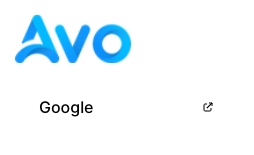
When you add the target: :_blank option, a tiny external link icon will be displayed.
link_to options
path
This is the path of the item. It may be ommited to make the API look like Rail's
config.main_menu = -> {
# These two are equivalent
link_to "Home", path: main_app.root_path
link_to "Home", main_app.root_path
}data
You may add arbitraty data attributes to your link.
You can make a link execute a put, post, or delete request similar to how you use the data-turbo-method attribute.
config.main_menu = -> {
link_to "Sign out!", main_app.destroy_user_session_path, data: { turbo_method: :delete }
}-> render
The render method will render renderable objects like partials or View Components.
You can even pass locals to partials. The partials follow the same pattern as the regular render method.
render "avo/sidebar/items/custom_tool"
render "avo/sidebar/items/custom_tool", locals: { something: :here }
render Super::Dooper::Component.new(something: :here)-> resource
To make it a bit easier, you can use resource to quickly generate a link to one of your resources. For example, you can pass a short symbol name :user or the full name Avo::Resources::User.
resource :posts
resource "Avo::Resources::Comments"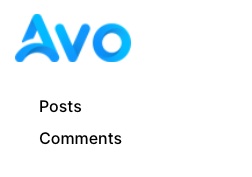
You can also change the label for the resource items to something else.
resource :posts, label: "News posts"Additionally, you can pass the params option to the resource items to add query params to the link.
resource :posts, params: { status: "published" }
resource :users, params: -> do
decoded_filter = {"Avo::Filters::IsAdmin"=>["non_admins"]}
{ encoded_filters: Avo::Filters::BaseFilter.encode_filters(decoded_filter)}
end-> dashboard
Similar to resource, this is a helper to make it easier to reference a dashboard. You pass in the id or the name of the dashboard.
dashboard :dashy
dashboard "Sales"
You can also change the label for the dashboard items to something else.
dashboard :dashy, label: "Dashy Dashboard"-> section
Sections are the big categories in which you can group your menu items. They take name and icon options.
section "Resources", icon: "heroicons/outline/academic-cap" do
resource :course
resource :course_link
end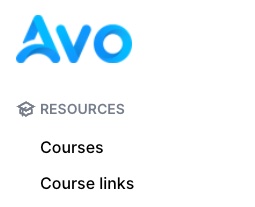
-> group
Groups are smaller categories where you can bring together your items.
group "Blog" do
resource :posts
resource :categories
resource :comments
end
-> all_resources
Renders all resources, except those explicitly excluded.
Arguments:
except: (Array, optional) – A list of resource names to be excluded.
Example:
section "App", icon: "heroicons/outline/beaker" do
group "Resources", icon: "resources" do
all_resources except: [:users, :orders]
end
endIn the example above, all resources will be rendered except Avo::Resources::Users and Avo::Resources::Orders.
-> all_dashboards
Renders all dashboards, except those explicitly excluded.
Arguments:
except: (Array, optional) – A list of dashboard names to be excluded.
Example:
section "App", icon: "heroicons/outline/beaker" do
group "Dashboards", icon: "dashboards" do
all_dashboards except: [:sales, :analytics]
end
endIn this example, all dashboards will be rendered except Avo::Resources::Sales and Avo::Resources::Analytics.
-> all_tools
Renders all tools.
section "App", icon: "heroicons/outline/beaker" do
group "All tools", icon: "tools" do
all_tools
end
endall_ helpers
section "App", icon: "heroicons/outline/beaker" do
group "Dashboards", icon: "dashboards" do
all_dashboards
end
group "Resources", icon: "resources" do
all_resources
end
group "All tools", icon: "tools" do
all_tools
end
endWARNING
The all_resources helper is taking into account your authorization rules, so make sure you have def index? enabled in your resource policy.
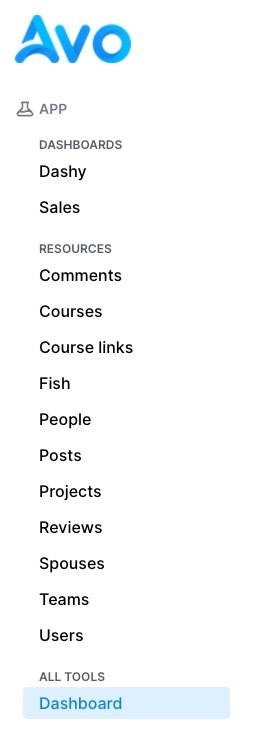
Item visibility
The visible option is available on all menu items. It can be a boolean or a block that has access to a few things:
- the
current_user. Given that you set a way for Avo to know who the current user is, that will be available in that block call - the
contextobject. - the
paramsobject of that current request - the
view_contextobject. Theview_contextobject lets you use the route helpers. eg:view_context.main_app.posts_path.
# config/initializers/avo.rb
Avo.configure do |config|
config.main_menu = -> {
resource :user, visible: -> do
context[:something] == :something_else
end
}
endAdd data attributes to items
Since v2.16You may want to add special data attributes to some items and you can do that using the data option. For example you may add data: {turbo: false} to make a regular request for a link.
# config/initializers/avo.rb
Avo.configure do |config|
config.main_menu = -> {
resource :user, data: {turbo: false}
}
endUsing authorization rules
When you switch from a generated menu to a custom one, you might want to keep using the same authorization rules as before. To quickly do that, use the authorize method in the visible option.
# config/initializers/avo.rb
Avo.configure do |config|
config.main_menu = -> {
resource :team, visible: -> do
# authorize current_user, MODEL_THAT_NEEDS_TO_BE_AUTHORIZED, METHOD_THAT_NEEDS_TO_BE_AUTHORIZED
authorize current_user, Team, "index?", raise_exception: false
end
}
endIcons
For Sections, you can use icons to make them look better. You can use some local ones that we used throughout the app and all heroicons designed by Steve Schoger. In addition, you can use the solid or outline versions. We used the outline version throughout the app.
section "Resources", icon: "heroicons/outline/academic-cap" do
resource :course
end
section "Resources", icon: "heroicons/solid/finger-print" do
resource :course
end
section "Resources", icon: "heroicons/outline/adjustments" do
resource :course
endIcons on resource, dashboard, and link_to items
You can add icons to other menu items like resource, dashboard, and link_to.
link_to "Avo", "https://avohq.io", icon: "globe"Collapsable sections and groups
When you have a lot of items they can take up a lot of vertical space. You can choose to make those sidebar sections collapsable by you or your users.
section "Resources", icon: "resources", collapsable: true do
resource :course
end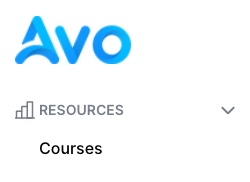
That will add the arrow icon next to the section to indicate it's collapsable. So when your users collapse and expand it, their choice will be stored in Local Storage and remembered in that browser.
Default collapsed state
You can however, set a default collapsed state using the collapsed option.
section "Resources", icon: "resources", collapsable: true, collapsed: true do
resource :course
end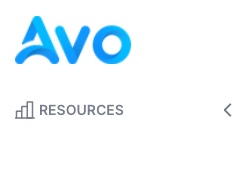
You might want to allow your users to hide certain items from view.
Authorization
Watch the demo videoIf you use the authorization feature, you will need an easy way to authorize your items in the menu builder. For that scenario, we added the authorize helper.
Avo.configure do |config|
config.main_menu = -> {
resource :team, visible: -> {
# authorize current_user, THE_RESOURCE_MODEL, THE_POLICY_METHOD, raise_exception: false
authorize current_user, Team, "index?", raise_exception: false
}
}
endUse it in the visible block by giving it the current_user (which is available in that block), the class of the resource, the method that you'd like to authorize for (default is index?), and tell it not to throw an exception.
Now, the item visibility will use the index? method from the TeamPolicy class.
Profile menu
The profile menu allows you to add items to the menu displayed in the profile component. The sign-out link is automatically added for you.
You may add the icon option to the profile_menu links.
# config/initializers/avo.rb
Avo.configure do |config|
config.profile_menu = -> {
link_to "Profile", path: "/profile", icon: "user-circle"
}
end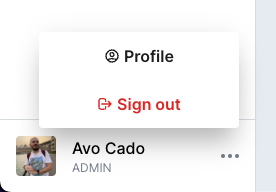
Forms in profile menu
It's common to have forms that POST to a path to do sign ut a user. For this scenario we added the method and params option to the profile item link_to, so if you have a custom sign out path you can do things like this.
# config/initializers/avo.rb
Avo.configure do |config|
config.profile_menu = -> {
link_to "Sign out", path: main_app.destroy_user_session_path, icon: "user-circle", method: :post, params: {custom_param: :here}
}
endCustom content in the profile menu
You might, however, want to add a very custom form or more items to the profile menu. For that we prepared the _profile_menu_extra.html.erb partial for you.
bin/rails generate avo:eject --partial :profile_menu_extraThis will eject the partial and you can add whatever custom content you might need.
<%# Example link below %>
<%#= render Avo::ProfileItemComponent.new label: 'Profile', path: '/profile', icon: 'user-circle' %>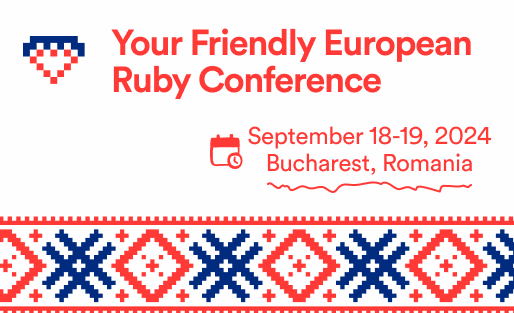 Friendly.rb - Your friendly European Ruby Conference
Friendly.rb - Your friendly European Ruby Conference